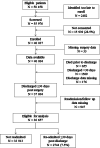Risk Factors for Hospital Readmission Following Noncardiac Surgery: International Cohort Study
- PMID: 38911647
- PMCID: PMC11192008
- DOI: 10.1097/AS9.0000000000000417
Risk Factors for Hospital Readmission Following Noncardiac Surgery: International Cohort Study
Abstract
Objective: To determine timing and risk factors associated with readmission within 30 days of discharge following noncardiac surgery.
Background: Hospital readmission after noncardiac surgery is costly. Data on the drivers of readmission have largely been derived from single-center studies focused on a single surgical procedure with uncertainty regarding generalizability.
Methods: We undertook an international (28 centers, 14 countries) prospective cohort study of a representative sample of adults ≥45 years of age who underwent noncardiac surgery. Risk factors for readmission were assessed using Cox regression (ClinicalTrials.gov, NCT00512109).
Results: Of 36,657 eligible participants, 2744 (7.5%; 95% confidence interval [CI], 7.2-7.8) were readmitted within 30 days of discharge. Rates of readmission were highest in the first 7 days after discharge and declined over the follow-up period. Multivariable analyses demonstrated that 9 baseline characteristics (eg, cancer treatment in past 6 months; adjusted hazard ratio [HR], 1.44; 95% CI, 1.30-1.59), 5 baseline laboratory and physical measures (eg, estimated glomerular filtration rate or on dialysis; HR, 1.47; 95% CI, 1.24-1.75), 7 surgery types (eg, general surgery; HR, 1.86; 95% CI, 1.61-2.16), 5 index hospitalization events (eg, stroke; HR, 2.21; 95% CI, 1.24-3.94), and 3 other factors (eg, discharge to nursing home; HR, 1.61; 95% CI, 1.33-1.95) were associated with readmission.
Conclusions: Readmission following noncardiac surgery is common (1 in 13 patients). We identified perioperative risk factors associated with 30-day readmission that can help frontline clinicians identify which patients are at the highest risk of readmission and target them for preventive measures.
Keywords: cohort study; hospital readmission; noncardiac surgery; risk factors.
Copyright © 2024 The Author(s). Published by Wolters Kluwer Health, Inc.
Figures


References
-
- Weiser TG, Regenbogen SE, Thompson KD, et al. . An estimation of the global volume of surgery: a modelling strategy based on available data. Lancet. 2008;372:139–144. - PubMed
-
- Devereaux PJ, Sessler DI. Cardiac complications in patients undergoing major noncardiac surgery. N Engl J Med. 2015;373:2258–2269. - PubMed
-
- Glance LG, Kellermann AL, Osler TM, et al. . Hospital readmission after noncardiac surgery: the role of major complications. JAMA Surg. 2014;149:439–445. - PubMed
-
- Canadian Institute for Health Information. All-Cause Readmission to Acute Care and Return to the Emergency Department. 2012. Available at: https://publications.gc.ca/site/eng/9.698629/publication.html. Accessed August 12, 2023.
Associated data
LinkOut - more resources
Full Text Sources
Medical
Miscellaneous

